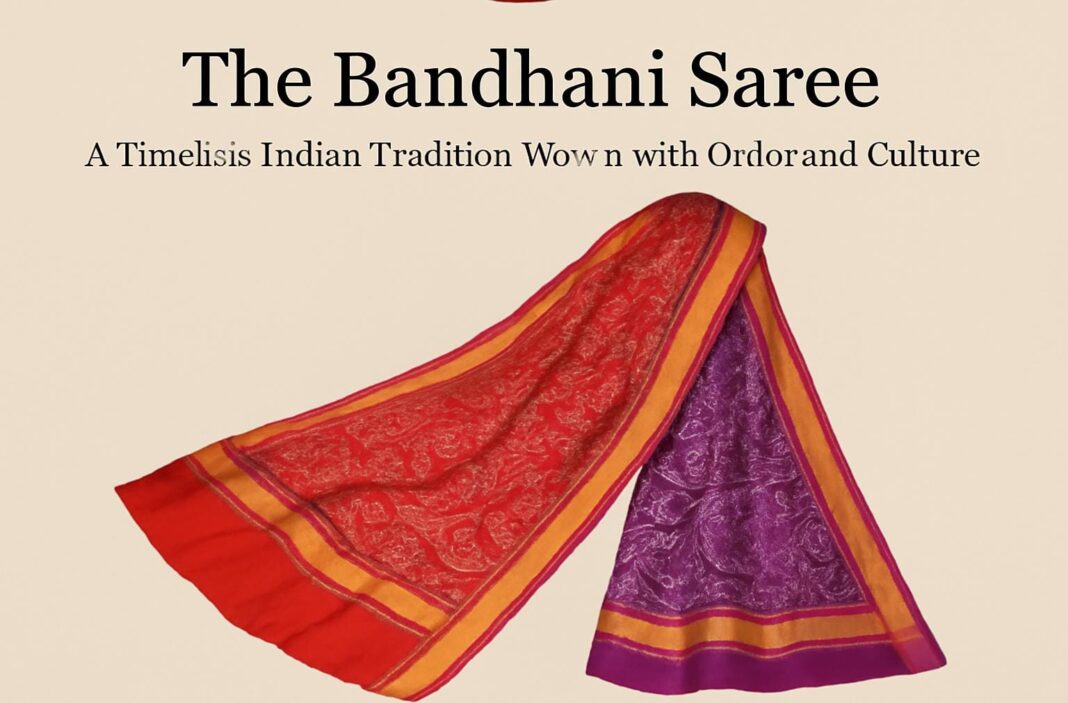Sarees are not just garments; they are an experience. The fabric wraps around you like history, culture, and beauty all at once. One of the most enchanting varieties of sarees is the Bandhani saree, a creation of rich tradition, vibrant colors, and intricate designs. But what makes the Bandhani saree so special? Let’s dive into its fascinating history, the unique art of Bandhani, and how this saree has found its place in the hearts of modern fashion lovers.
What is a Bandhani Saree?
A Bandhani saree is a traditional Indian saree known for its eye-catching tie-dye technique called “Bandhani.” This ancient art form involves tying small portions of the fabric with thread and then dyeing it, creating beautiful, multicolored patterns. These patterns can range from dots to intricate designs like waves, squares, and even floral motifs. The tie-dye process gives the fabric a unique look, making each saree distinct and one of a kind.
Originating from the western states of India—primarily Gujarat and Rajasthan—Bandhani sarees are now worn across the country. While they were initially worn by women in rural communities, today, Bandhani sarees are a symbol of elegance and are worn by brides, at festivals, and on all sorts of special occasions.
The Fascinating History of Bandhani
The roots of Bandhani go back thousands of years. In fact, some believe that this technique was used as far back as the 5th century, making it one of the oldest forms of textile dyeing in India. The art was initially practiced by the nomadic communities of Rajasthan, who needed brightly colored textiles for their celebrations and daily wear.
The term “Bandhani” is derived from the Sanskrit word bandhana, meaning to tie. The process involves tightly knotting the fabric with threads in small sections, followed by dyeing the fabric to create stunning, vibrant patterns. The skillful art of Bandhani is passed down through generations, making it a rich part of India’s cultural heritage.
Over time, Bandhani sarees have evolved, with new styles, colors, and patterns emerging. However, the traditional tie-dye technique remains the heart of every Bandhani saree, preserving its historical charm.
How Bandhani Sarees are Made
Creating a Bandhani saree is a meticulous process that requires skill, patience, and creativity. Here’s a simplified breakdown of how Bandhani sarees are made:
- Choosing the Fabric: The process begins with selecting the right fabric, usually cotton, silk, or georgette, which serves as the base for the tie-dyeing process.
- Tying the Fabric: Artisans tie small sections of the fabric using a technique that ensures that dye will not reach those parts. These ties are made using fine threads, and the tighter the tie, the more intricate and detailed the pattern will be.
- Dyeing the Fabric: Once the fabric is tied, it is dyed using a variety of natural and synthetic dyes. Depending on the design, the saree can be dyed multiple times to achieve a range of colors.
- Drying and Unwrapping: After the dyeing process is completed, the fabric is left to dry. Once dry, the ties are carefully undone to reveal the vibrant patterns on the fabric.
The result is a beautiful Bandhani saree with unique, vibrant patterns that capture the essence of the traditional art form.
Popular Designs and Patterns
Bandhani sarees come in an endless variety of designs. Some of the most popular Bandhani patterns include:
- Leheriya: This pattern creates a wave-like effect on the fabric, resembling the movement of the sea.
- Shikari: This design consists of circular dots arranged in a way that resembles animal footprints or marks, often symbolizing the connection with nature.
- Chandrokhani: This involves creating beautiful square or rectangular motifs within a grid pattern.
- Bundi: A type of design that includes small circular dots arranged in a random pattern.
These patterns are often accompanied by borders that feature intricate embroidery or mirror work, further enhancing the saree’s beauty.
The Bandhani Saree in Modern Fashion
While Bandhani sarees have deep roots in traditional Indian culture, they’ve evolved over time to fit into modern fashion trends. Today, Bandhani sarees are worn by women of all ages and backgrounds, both in India and internationally. Their vibrant colors and stunning designs make them a go-to choice for weddings, festivals, and cultural events.
Fashion designers have also embraced the Bandhani technique, incorporating it into contemporary collections. Bandhani sarees are now available in a range of fabrics, from light cotton for everyday wear to luxurious silks for formal occasions. They are often paired with stylish blouses in modern cuts, adding a fusion of tradition and modernity to the look.
Why Choose a Bandhani Saree?
So, why should you choose a Bandhani saree? Here are a few reasons:
- Uniqueness: Since each Bandhani saree is hand-dyed and tied, no two sarees are identical. When you wear a Bandhani saree, you are wearing a one-of-a-kind piece of art.
- Rich Tradition: Wearing a Bandhani saree connects you with an ancient tradition, allowing you to appreciate the culture and artistry behind it.
- Vibrant Colors: The tie-dye process gives the saree a beautiful burst of colors, making it perfect for festive occasions and celebrations.
- Versatility: Despite being traditional, Bandhani sarees can be styled in various ways, allowing them to be worn for both casual and formal events.
Conclusion: The Timeless Appeal of the Bandhani Saree
In a world of fast fashion, Bandhani sarees stand as a beautiful reminder of the importance of craftsmanship, culture, and tradition. The vibrant colors and intricate patterns, along with the deep cultural significance, make Bandhani sarees a perfect addition to any wardrobe. Whether you’re attending a wedding, a festival, or just want to add some tradition to your everyday style, the Bandhani saree is sure to make you stand out.
By choosing a Bandhani saree, you’re not just choosing a piece of clothing; you’re embracing an age-old tradition that has been passed down through generations. And in that colorful, tied-up fabric, you’re wearing a piece of history.



